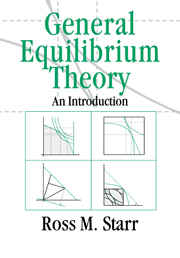Book contents
- Frontmatter
- Contents
- List of illustrations
- Foreword
- Preface
- Table of notation
- A Getting started
- B An economy with bounded production technology, supply and demand functions
- C An economy with unbounded production technology, supply and demand functions
- D Welfare economics
- E Bargaining and equilibrium: The core
- F The scope of markets
- G An economy with supply and demand correspondences
- H Conclusion
- Bibliography
- Index
C - An economy with unbounded production technology, supply and demand functions
Published online by Cambridge University Press: 05 June 2012
- Frontmatter
- Contents
- List of illustrations
- Foreword
- Preface
- Table of notation
- A Getting started
- B An economy with bounded production technology, supply and demand functions
- C An economy with unbounded production technology, supply and demand functions
- D Welfare economics
- E Bargaining and equilibrium: The core
- F The scope of markets
- G An economy with supply and demand correspondences
- H Conclusion
- Bibliography
- Index
Summary
Our plan in Chapters 8 to 11 is to weaken the boundedness restrictions built into the model of Chapters 4 to 7. We will allow firm technology sets to be unbounded and allow households to choose from budget sets limited only by income and not by direct limits on the size of consumption plans. In equilibrium, prices will guide firms and households to well-defined (bounded) equilibrium allocations.
Remember the principal characterization of firm and household behavior: maximization of a criterion function (profit or utility) subject to a constraint (technology or budget). This results in a well-defined outcome, a supply or demand function, if the criterion is a continuous function of its arguments and the constraint set is compact and hence bounded (Corollary 2.2). In Chapters 4 to 7 we achieved boundedness of the constraint sets by assumption P.VI and definition (the restriction |x| ≤ c in the definition of prevents budget sets from being unbounded when some prices are zero). This is inadequate. Unbounded production technology sets make sense and our theory should be able to deal with them; if a firm could acquire arbitrarily large inputs it would find it technically possible to produce arbitrarily large outputs. Scarcity – the limits of available inputs – should be communicated by prices, not by the modeler's assumptions. Price incentives should lead firms to choose finite inputs and outputs as an optimizing choice.
- Type
- Chapter
- Information
- General Equilibrium TheoryAn Introduction, pp. 109 - 110Publisher: Cambridge University PressPrint publication year: 1997



